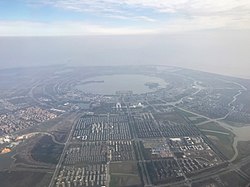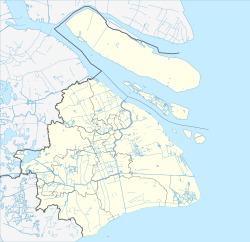Nanhui New City
30°54′N121°56′E/ 30.900°N 121.933°E
This article has multiple issues.Please helpimprove itor discuss these issues on thetalk page.(Learn how and when to remove these template messages)
|
Nanhui New City
Nam hối tân thành Nanhwei | |
|---|---|
 Dishui Lake from Above | |
| Coordinates:30°54′N121°56′E/ 30.900°N 121.933°E | |
| Country | China |
| Municipality | Shanghai |
| District | Pudong |
| Area | |
| • Total | 277.66 km2(107.21 sq mi) |
| Population | |
| • Total | 600,000 |
| • Density | 2,200/km2(5,600/sq mi) |
| Time zone | UTC+8(China Standard Time (CST)) |
Nanhui New City(Chinese:Nam hối tân thành) is aplanned citylocated in thePudongNew Area ofShanghai,China. It was formerly calledLingang New City( lâm cảng tân thành ) until it was renamed in April 2012.[1]
Construction began in 2003 and is scheduled to be completed in 2020, with the German architecture companyGerkan, Marg and Partnersleading the project. The project is estimated to have cost $4.5 billion. The city is aimed to house 450,000 to 800,000 residents while attracting 10 million annual tourists.[2][3]
Location
[edit]The site is located at the tip of the peninsula between theYangtzeand theQiantangrivers onHangzhou Bay.It is approximately 60 kilometers southeast of downtownShanghai.A major portion of the site wasreclaimed from the sea.[4]
The city was slated to become a "mini-Hong Kong". However, despite real estate developments being sold quickly, people have been reluctant to move in. To help vitalize the city, eight university campuses have been built on the west side of Nanhui New City, bringing in more than 100,000 students.[5][6]In August 2019, it was announced that the area will be included in theShanghai Free-Trade Zone.[7]
Attractions
- Shanghai Haichang Ocean Park
- Wintastar indoor ski resort
- Shanghai Planetarium
- China Maritime Museum, Shanghai
See also
[edit]References
[edit]- ^"China's 'sponge cities' are turning streets green to combat flooding".The Guardian.27 December 2017.Archivedfrom the original on 20 November 2020.Retrieved11 December2020.
- ^Yang, Jian (15 February 2017)."Polar and ski parks are coming to Lingang".Shanghai Daily.Archivedfrom the original on 16 July 2020.Retrieved11 December2020.
- ^Garfield, Leanna (16 May 2017)."7 mega-projects that will transform Chinese cities by 2050".Business Insider.Archivedfrom the original on 4 November 2019.Retrieved11 December2020.
- ^Shepard, Wade (30 August 2016)."Why China Never Gives Up On Its Ghost Cities".Forbes.Archivedfrom the original on 11 December 2020.Retrieved11 December2020.
- ^Shepard, Wade (19 January 2016)."One Way That China Populates Its Ghost Cities".Forbes.Archivedfrom the original on 11 December 2020.Retrieved11 December2020.
- ^Batchelor, Tom (23 April 2015)."Staggering images reveal China's MEGA-CITIES".express.co.uk.Archivedfrom the original on 10 February 2018.Retrieved11 December2020.
- ^"Lingang's inclusion in Shanghai Free-Trade Zone a Chance for Beijing to Conduct Bold Reforms".South China Morning Post.14 August 2019.Archivedfrom the original on 11 December 2020.Retrieved11 December2020.

